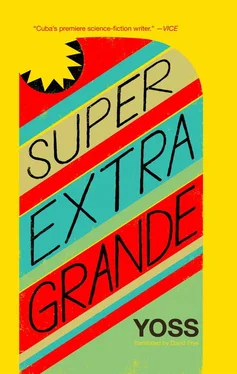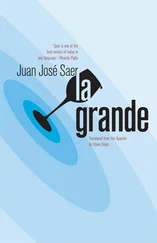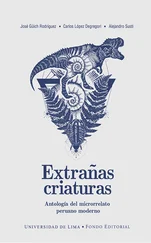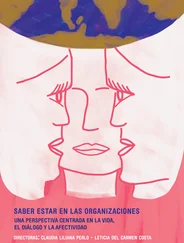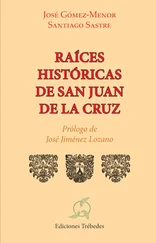I never really got physically intimate with students from other races—there were Laggorus, Amphorians, and Cetians studying at Anima Mundi—but I swear that, other than interspecies sex, which I still have a few prejudices about, there isn’t much I didn’t try.
The lectures weren’t especially difficult for a more or less diligent student, either. Though biology and veterinary studies have changed a bit in the era of the González drive.
We didn’t study much about the other six of the “lucky seven” intelligent races. Their physiology and illnesses are the nearly exclusive fiefdom of interspecies medicine, whose professionals are the most prized in the entire Milky Way, perhaps because it takes at least ten years to complete enough studies to deal with even three or four races. As for doctors who can treat the diseases of every rational species… you could count every one in the galaxy on the fingers of one hand and still have enough fingers left to scratch yourself.
On Earth, before the González drive, biologists were always a few steps ahead of veterinarians when it came to exotic animals. Veterinarians, on the other hand, were indisputably more knowledgeable about the species humans had coexisted with for centuries.
To put it bluntly: If you were rich enough and eccentric enough to keep a cuscus, a rare arboreal marsupial from New Guinea, as a pet, and it refused to eat, you’d have to take it to a biologist, who’d tell you seven or eight theories about the difference between placental mammals and their primitive marsupial predecessors, before finally explaining that we really know very little about them.
And then he’d charge you an arm and a leg for the lecture.
On the other hand, if your dog got a fever, the vet would list twenty or thirty possible causes, figure out which was most likely in the case of your breed of mutt, do a blood test and a stool exam or two, and give you a prescription for the precise dose of medication that would probably cure it.
And also charge you an arm and a leg, of course.
Not that he shouldn’t. Keeping pets was always a luxury, and luxuries have to be expensive, by definition, don’t they?
But it’s a very different story now. Any mush-brained crew member on a faster-than-light exploration ship can land on a methane planet and carry off, among the samples he brings back onto the ship, a magenta anemone that shoots venomous darts from its tentacles.
Since it’s a unique specimen until its discoverer feels like giving out the coordinates of the world where he found it, both biologists and veterinarians study it. Who gets to it first, who second, depends only on which of them is closer at the time.
But everything they discover about the enchanting critter goes into a single database, accessible on the holonet, which is constantly receiving contributions from explorers, biologists, and veterinarians—and not only from humans but also from each of the other six intelligent races in the galaxy.
So the next person who runs into a specimen of the species in question will already know more or less what to expect from it. What environmental conditions, temperature, light level, and atmospheric composition (oxygen, methane, fluorine, whatever gas it breathes) it prefers. What it eats, what predators it fears may eat it, how it reproduces (if we’re very lucky), how it gets sick and from what, what it can die of (which, unfortunately, is always one of the first things we learn about an animal), and various other details of general interest.
The result is that biology and veterinary medicine have now merged. It helps a little that you no longer have to rack your brains memorizing every known fact about particular species. Good thing! Because there are billions of them. What we up-and-coming veterinary biologists learned at Anima Mundi was simply how to recognize different species, how to classify them into some of the basic types, which are basically organized according to what they breathe, and how to follow our intuition from then on.
Of course, almost all of us ended up specializing in some specific category, to make things easier. For example, my friend João de Oliveira from the planet Saudade, a compulsive gambler, focused on fluorine-breathing predators. He always liked making money and taking risks… and Kerkants and Parimazos pay well for their pets. Well enough for him to pay off his gambling debts.
Another friend, not a gambler but even more addicted to bars and cantinas than João, was Juni Tacho, who dreamed of knowing more than anyone else about social insects. The military was always his calling. In fact, he dropped out of veterinarian biology in his second year and enrolled in the Army of Earth. I haven’t heard from him since… But there are so many worlds, and so many soldiers…
In the finest sedentary, low-metabolism style of the Juhungans, Irma Korolyova, calm and cool, devoted herself to the study of hydrogen-breathing zoophytes, which might move one tentacle a day if you’re lucky.
One of the most diligent non-humanoid students at Anima Mundi, the Amphorian Murgh-Jauk-Larh, spent his time studying what he thought of as the most exotic creatures he had ever seen: none other than terrestrial dogs, which have lately become remarkably popular as expensive, extravagant pets among the rich and powerful in his methane-breathing race. And he’s climbed far up the social ladder. Almost as high as his bank account, I think.
I became the “Veterinarian to the Giants.” It wasn’t a carefully planned decision, I admit, but not one I made on the spur of the moment, either. The truth is, looking back on things now, I can say that life itself pushed me in this direction.
My exorbitant dimensions made the labs and practicals in parasitology, virology, and microbiology a real torture throughout my years of study. I think I set a record with the number of Petri dishes and microscopes I broke. Not to mention chair legs splintered in an average semester because they couldn’t take my weight.
And, man, the instruments! Tweezers, scalpels… Everything was too uncomfortably tiny and delicate for my old mitts. And when it came to using electron microscopes or microtomes, forget it, they didn’t even let me near. Those machines cost millions of solaria.
On the other hand, when things increased in scale, I felt I was in my element.
There was a marabunt from Sylaria to dissect? I’d be the first volunteer for the job. Armored, predatory lizard-fish that grow to several meters in length, marabunts live in their planet’s low mudflats. They have no equals as examples of the pros and cons of asexual reproduction through budding in higher vertebrates. But since they’re almost all mouth and teeth and have an incredibly resilient nervous system, it’s kind of risky to dissect them. It isn’t rare for a specimen that was thought dead an hour earlier to suddenly start snapping and biting, a reflex that could cost a distracted student his hand.
Or his whole arm, if he isn’t quick on his feet.
But with me, forget about it. Putting my body mass to good use, I created a new and very safe method for performing the operation, though one that not everyone can make use of, unfortunately. I’d sit right down on the monster’s head and dissect it as calmly as could be, knowing it wouldn’t be able to open its jaws, crushed as they were under all the kilograms of my rear end.
When my class had to vivisect a grendel, it was like a party for me.
Grendels are cave-dwelling crustaceans from Abyssalia. Radially symmetrical, they measure up to twenty meters from claw to claw (they have eight), and they’re so full of life that you can practically make picadillo of them before they decide to die.
When most of my classmates saw those fifty-centimeter macrocells throbbing and pulsing spasmodically with each cut, they threw up—and by the third year of veterinarian biology, it takes something genuinely disgusting to make a student vomit.
Читать дальше
